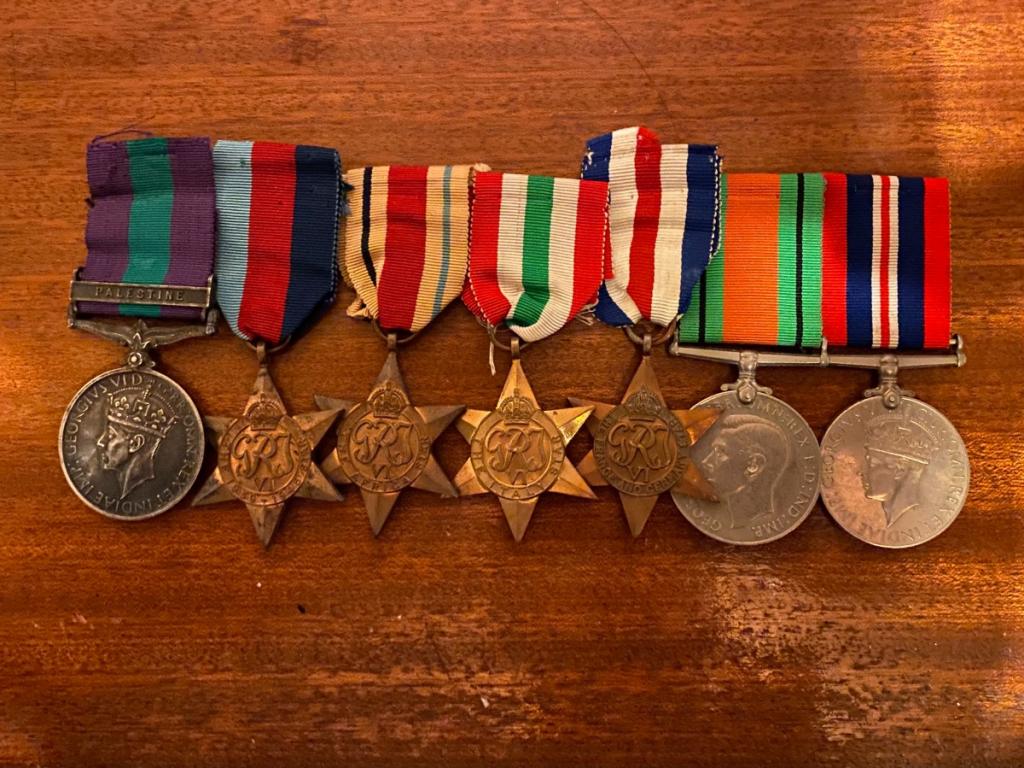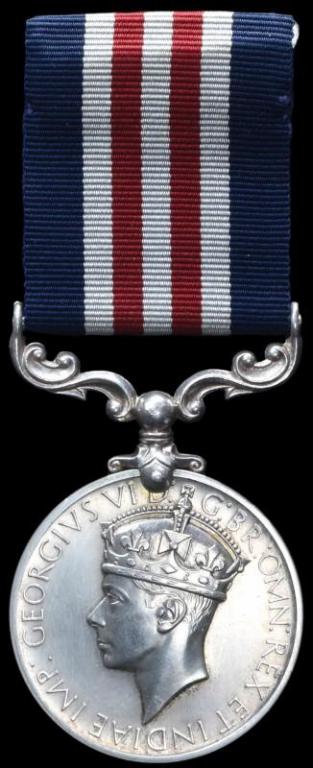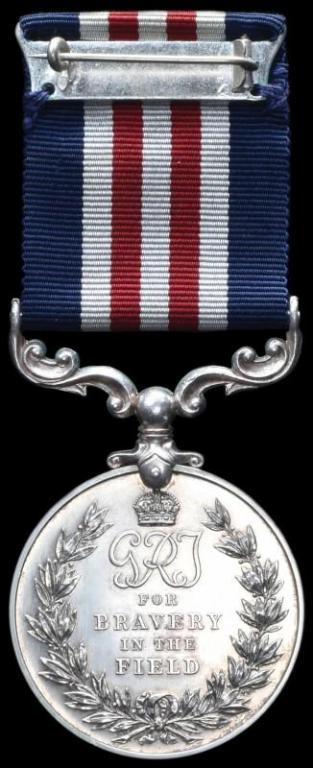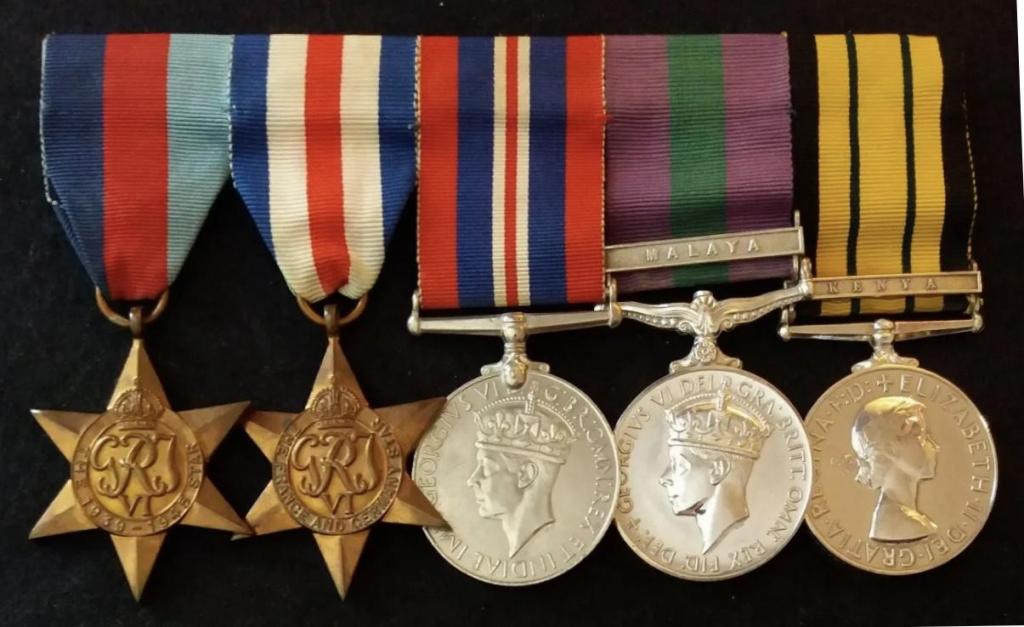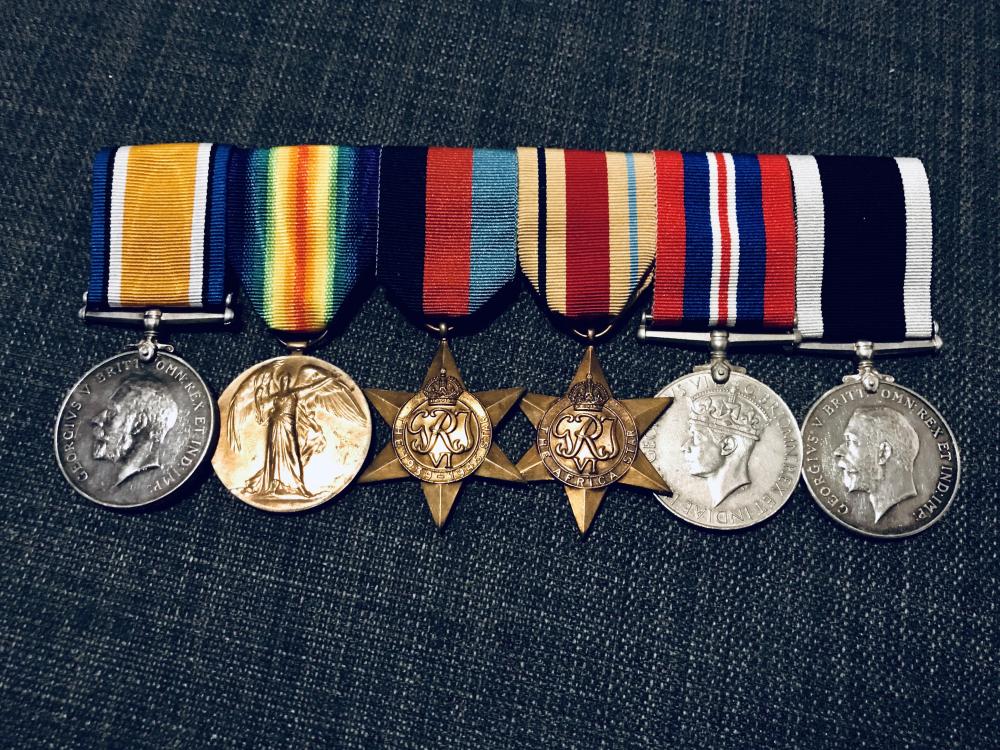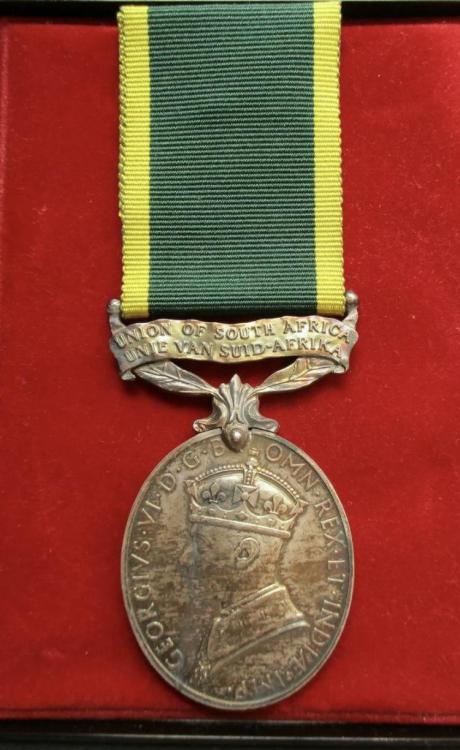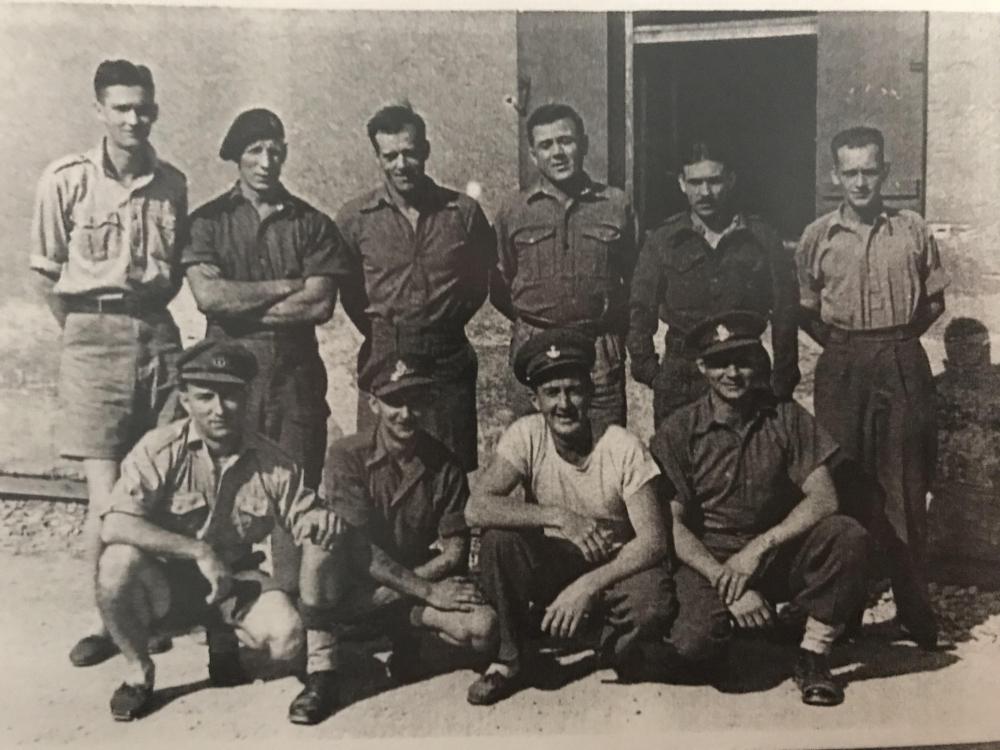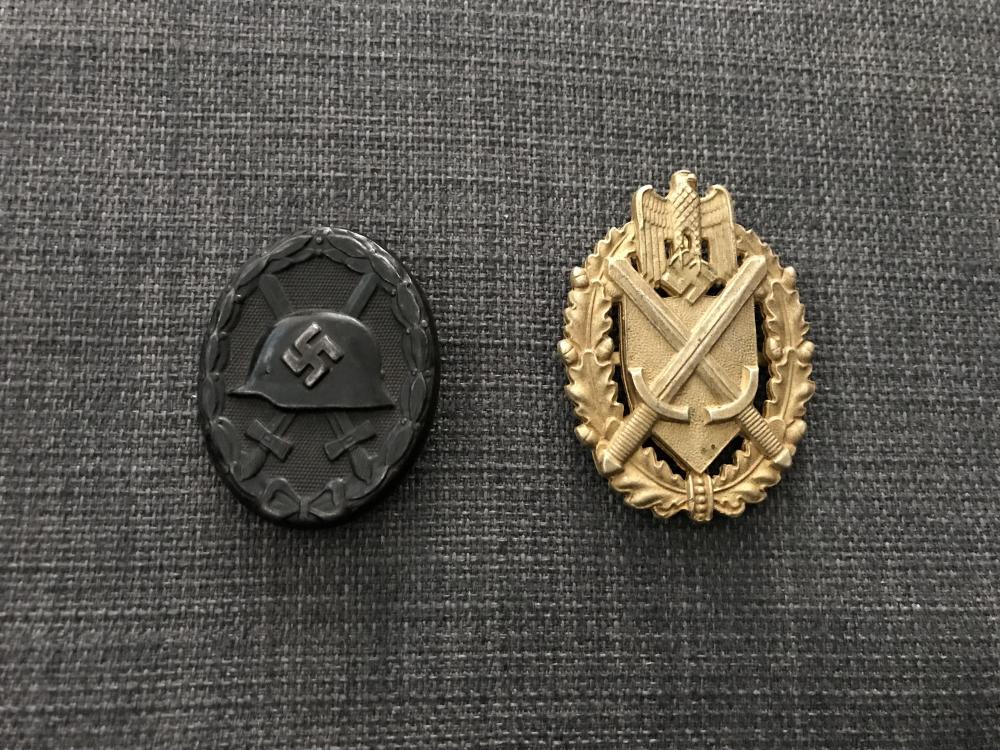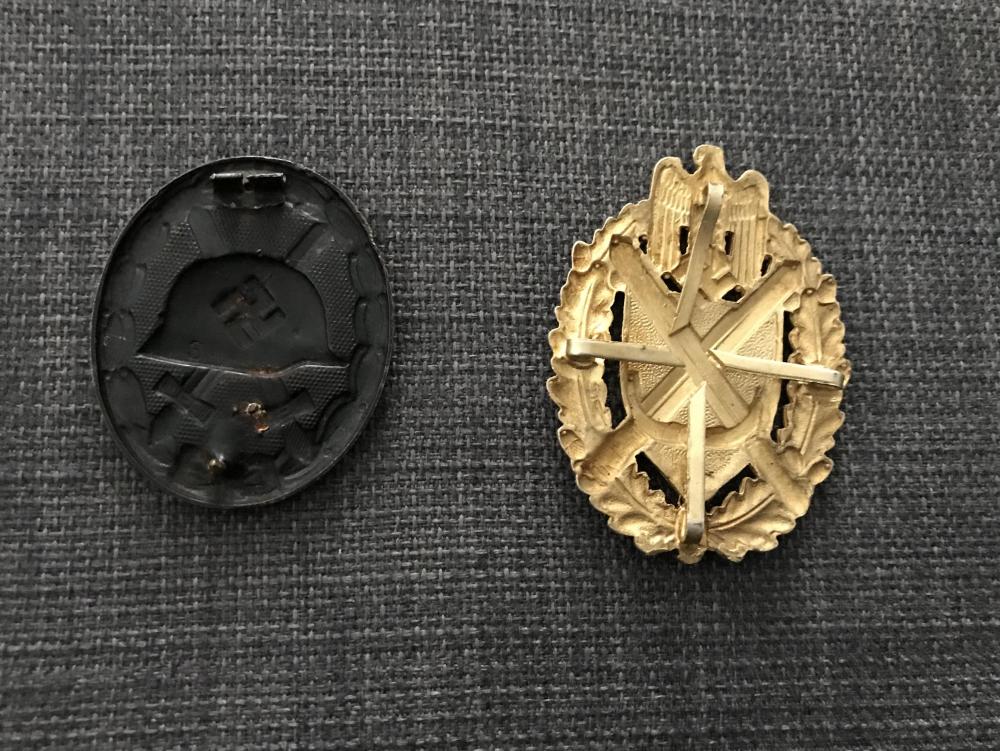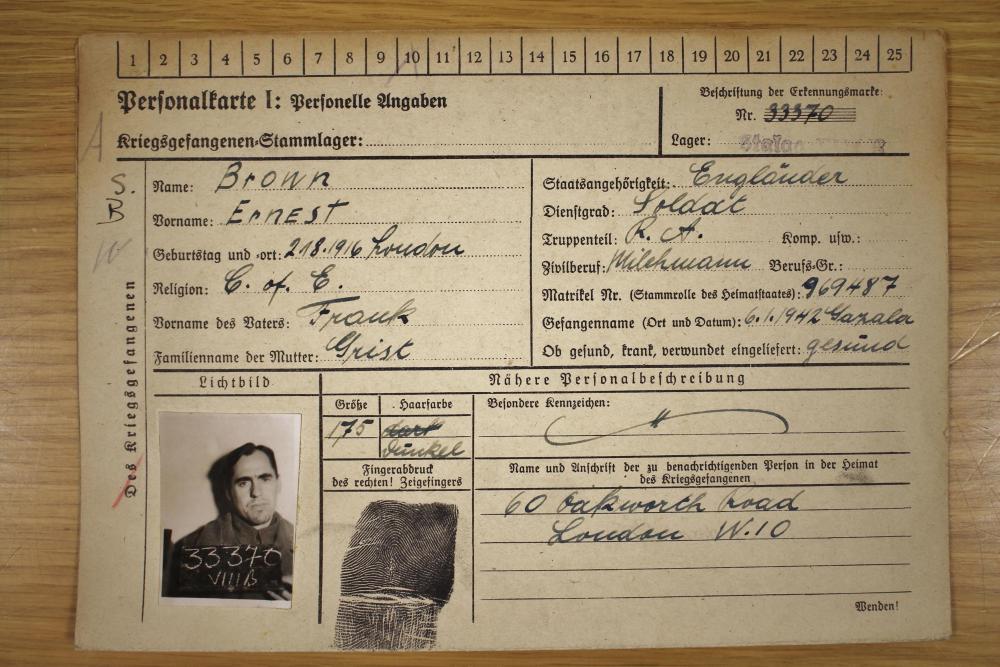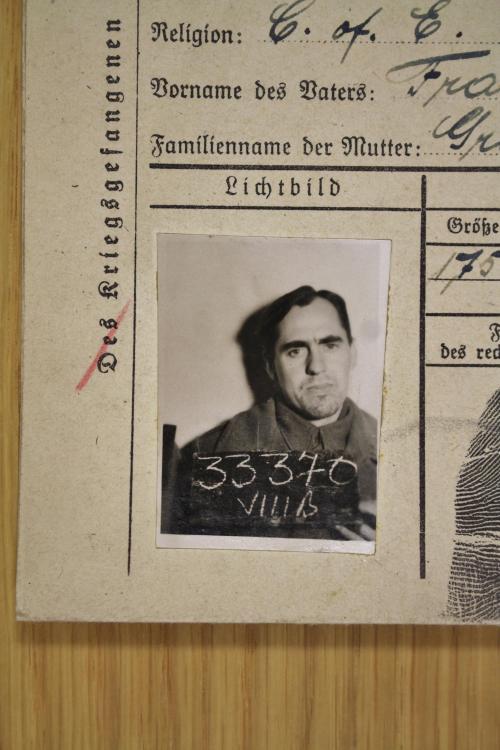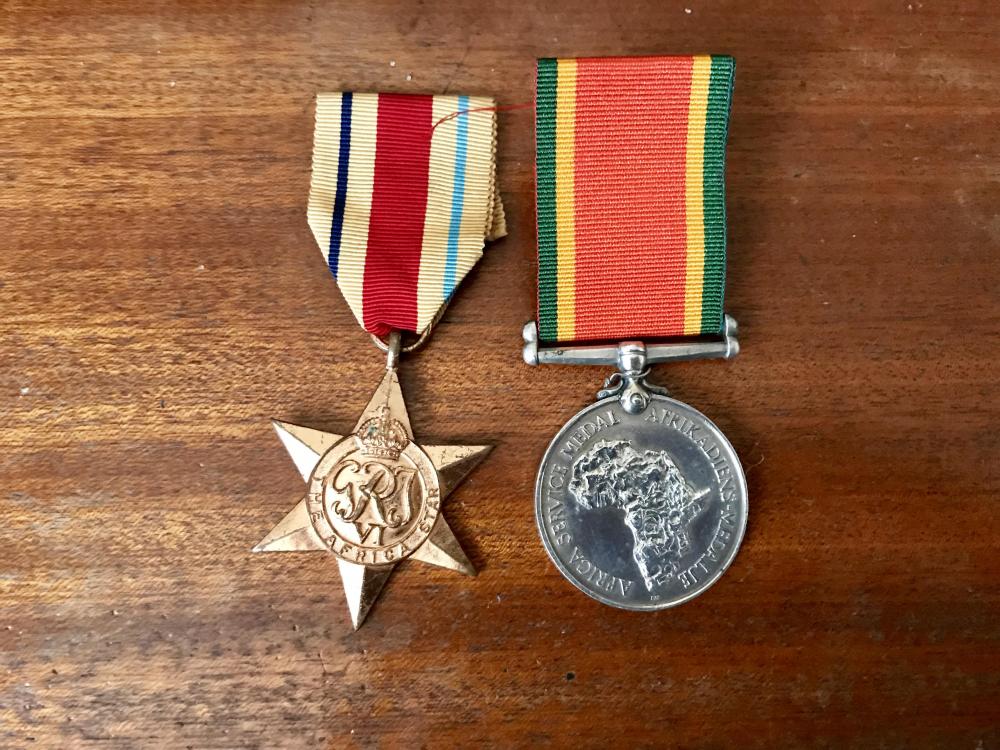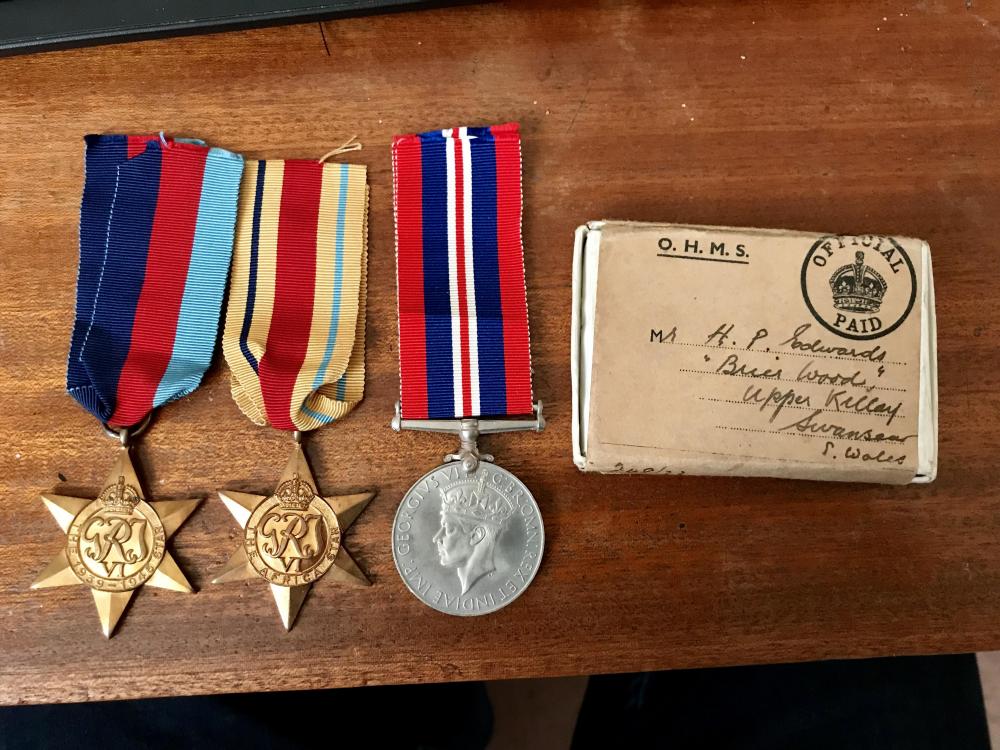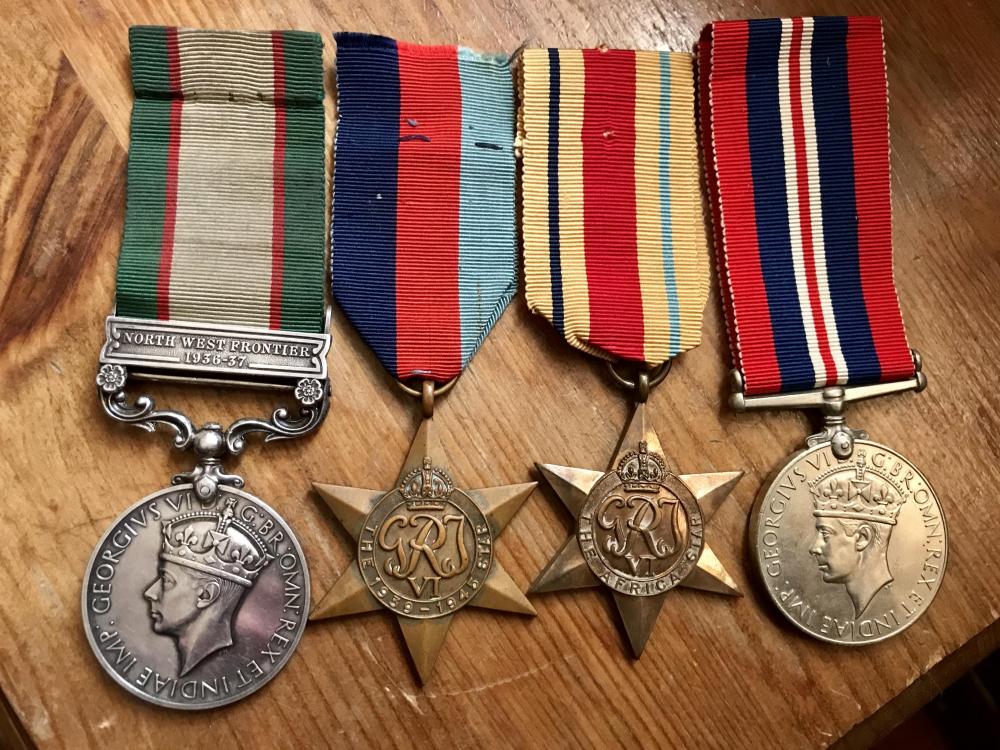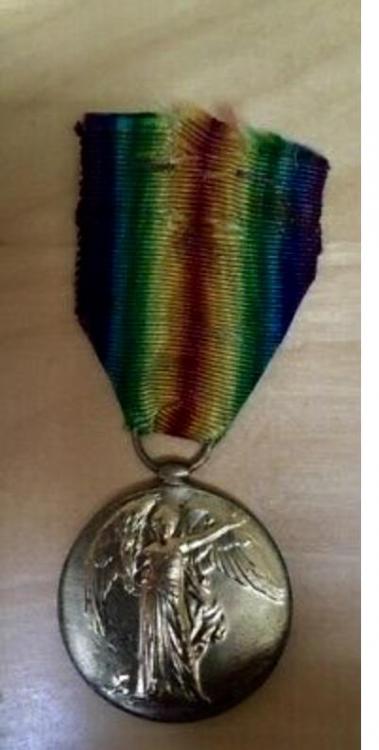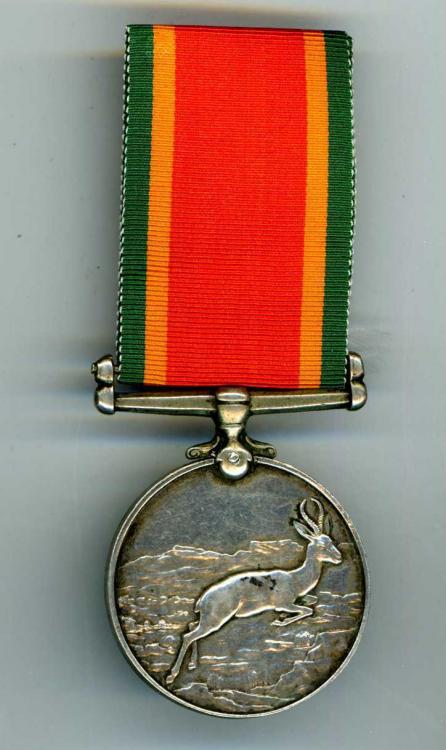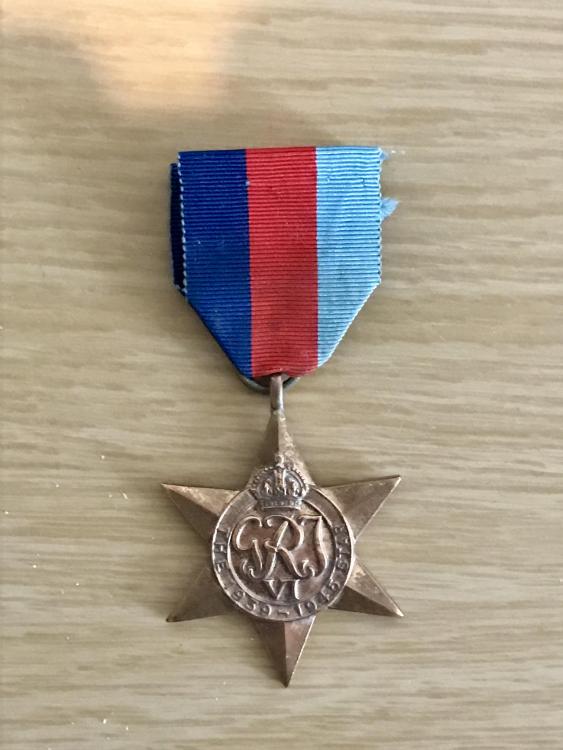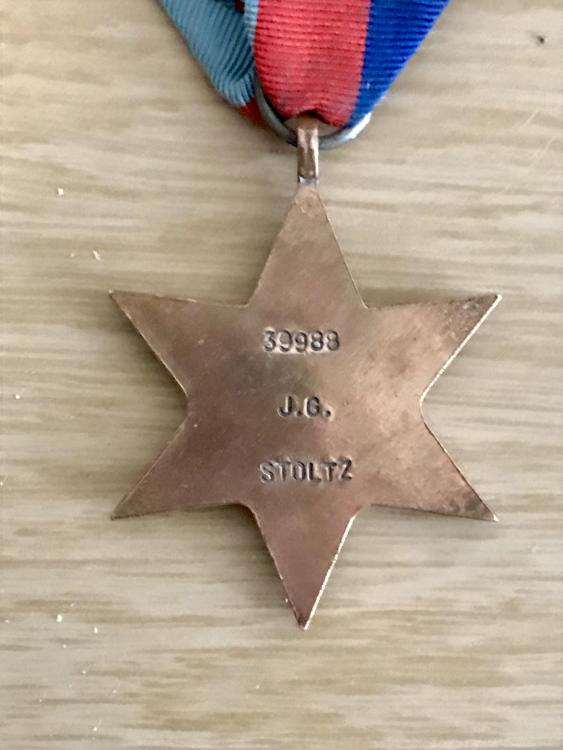-
Posts
220 -
Joined
-
Last visited
-
Days Won
11
Content Type
Profiles
Forums
Blogs
Gallery
Events
Store
Everything posted by POWCollector
-

HMS drake
POWCollector replied to Aniki's topic in Great Britain: Orders, Gallantry, Campaign Medals
HMS Drake is the name given for HMNB Devonport (Guzz). This is similar to HMS Excellent which is the NCHQ on Whale Island in Portsmouth. My Grandfathers LSGC is also named to a shore establishment so I think this is absolutely fine. -
A brilliant new addition! Thank you for educating me on this extraordinary battalion! It’s interesting to see some Elphinstones amongst the prisoners.... One of their relatives, John Elphinstone, was a Captain in the Black Watch and after capture in WW2 was sent to Oflag IV-C Colditz Castle. Due to his being King George VI nephew and cousin of Queen Elizabeth, he was placed as a prominente prisoner on the orders of Adolf Hitler and was to be used as a bargaining chip should the war not go in Germany’s favour. Thanks again and look forward to the next!
-
Next up is a very interesting group to a Crete POW and subsequent casualty. I have been looking for an MI9 debrief but as the national archives have been closed for a year, I am tired of waiting and will post now with the hope of embellishing with more detail at a later date! William Brown was born in 1920 to Mr and Mrs William Brown of Walkley, Sheffield, England. William Brown enlisted in the Argyll and Sutherland Highlanders with the service number 2982310 and served with the 1st battalion in Palestine before the second world war. When war broke out, the 1st Battalion were sent to the western desert and fought at the battle of Sidi Barani, the opening battle of Operation Compass, and thence to Crete. In Crete the German parachutists were decimated but ultimately the allies lost the battle with thousands being taken prisoner, William Brown included. William Brown was confirmed by the Germans as having been wounded and captured on Crete on the 23rd of May 1941. The prisoners were transported to mainland where the wounded were sent to hospital camps and the able bodied being transported in cattle trucks up to permanent pow camps in Poland and Germany. William Brown escaped either from the train or a hospital camp as he was next heard of in 1942 in neutral Turkey. He somehow made his way back to the UK where he was promoted to Sergeant. Sergeant William Brown got back into action serving with the 7th Battalion in Italy and North Western Europe. Sadly, William Brown was wounded and subsequently died of wounds on the 25th of October 1944 during the Attack on St. Michels Gestel and Vught. For more information on the battle, please follow this link: https://51hd.co.uk/accounts/st_michels_gestel_vught I am delighted to have this group in my collection. William Brown was clearly an excellent soldier and had a truly tragic war. From being wounded and taken prisoner in Crete, escaping to neutral Turkey and making his way home, to fighting again in Italy and Holland where he met his untimely end. Aged just 24 years old, William was buried in Groesbeek Cemetary in the Netherlands. The inscription on his headstone chosen by his parents reads "From battle front to heavenly rest. God took my dear son, One of the best." His medals are: General Service Medal Palestine, 1939-45 Star, Africa Star, Italy Star, France and Germany Star, Defence Medal, and War medal. It is nice to see a Defence Medal to a POW as this is a fairly uncommon occurrence.
-
Dear All, I am trying desperately (and unsuccessfully) to research a French officer who was captured in May 1940 and wound up at Colditz Castle, Oflag IV-C for his escapes. I have found his name (Captain Jean Tarrade) in Pat Reids book on Colditz but I wonder if anybody knows of any other books about Colditz perhaps written by the French? I am desperate to find details of how he escaped his previous camps as the LOH recommendation doesn't go into detail and to find out of any clandestine activity at Colditz itself. I would be very appreciative of help and would be willing to pay anybody who could procure service records etc if they exist. He went on to serve in French Indochina and North Africa post war. Many thanks, Rob
-
Hi guys, I own a group of medals and documents to confirmed Colditz POW Capt Jean Tarrade. His Legion D’Honour recommendation says that he made 3 escape attempts prior to being sent to Colditz and I would love to find out more information. After the French were removed, he was in Oflag X-C at Lubeck and organised the French resistance movement within the camp and subsequently disarmed the guards and secured the town upon liberation. Does anybody know how I can research this man further? French pows are not my usual bag. I have posted the group on ‘My POW collection’ thread on the Great Britain section of this forum. Many thanks!
-
My Apologies for the long delay in posting, but the national archives closure has meant that research has been impossible since March! However, I have a fantastic new medal in the collection which does not require much more research and I will share it now. 2752522 Sgt David Reid of the Black watch enlisted in 1928 with his civilian profession being listed as a miner. He was serving with the 51st Highland Division in France in June 1940 when he was captured. His MI9 POW Debrief takes up the story below: "I was rather badly wounded on 12 June 1940 and was with other casualties, in a truck making for St. Valery En Caux when we came under fire. I managed to crawl into a big clump of nettles and lost consciousness. Two hours later, I woke up in a German C.C.S. While I was lying there, a German kicked me on the head. The same man shot and killed two men of my regiment; L/Cpl Horne, who was wounded and Pte Glenn who had surrendered and was unarmed. The next day we were moved to Forges-Les-Eaux and three weeks later to a hospital at Rouen, where I remained until I was taken, on 2 April 1941, to the Val-De-Grace hospital in Paris, by way of St Quentin. On 13th April 1941, I escaped from the hospital in civilian clothes by climbing down from a window by means of sheets tied together. Once clear, I made for an address furnished me by helpers. Sgt Gare of my battalion was with me, but we parted company separately. From Paris, I was taken to a small village by car (16 APR) and then went by train with a guide to Tours (17 APR) where I received instructions to walk 25kms to Montrichard. Halfway my wounds began to trouble me and Sgt Gare went on. A farmer picked me up and he took me to his house at Les Ouches and the same night took me over the demarcation line, the river Cher, in his boat. I managed to crawl up the far bank unobserved, although there were German sentries on both banks. Three days later (20 APR) I was arrested by the French at Louches where I was interrogated by a Captain, who later secretly got me out of my cell and took me in his car to Chateauroux, giving me 300 francs before he left me. I was then guided to Marseilles but was then taken to St Hippolyte Du Fort. Later I was passed by the medical board, with 26 others, and left on 31 July for Spain and so home." David made his way to Spain successfully and into Gibraltar which he left on the 1st of October 1941 arriving in Gourock, Scotland on the 6th of October 1941. He spent some time in hospital in Edinburgh and was medically discharged from the Army. Interestingly, David's interview report has an Appendix A - List of Helpers. This field is noted 'Distribution: MI6'. Reputedly, Reverend Donald Caskie, The Tartan Pimpernel, sent one of his contacts to the Hospital in Paris and gave the men the address of helpers. Donald Caskie then met David Reid in Marseilles and assisted him with the medical board. For those of you unfamiliar with The Reverend Donald Caskie, I implore you to research him - The Tartan Pimpernel is a very good book and accessible on kindle for half price on amazon at the time of writing! This is a very special medal (despite it being a duplicate issue) as the story is fantastic and I am thrilled to have bought it. David Reid clearly had a tough time during his short war. He was severely wounded, he was mistreated by the German soldier whom he saw murder his comrades and he spent time 'on the run', fending for himself. Through grit and determination he managed to escape captivity and made his way home in just 6 months, a very short time indeed. Thanks for reading.
-
Next up is a lovely group to a man who made an escape attempt which includes one of my favourite medals; The Africa General Service Medal with Kenya clasp. Harold Ward Brown was born on the 8th June, 1919. His birth was registered in the district of Sculcoates, Yorkshire North Riding. In August 1938, at the age of 19 years, he enlisted into the Royal Army Service Corps, giving his civilian occupation as Driver, and home address as Bainton Grove, Endyke Lane, North Hull Estate, Hull, Yorkshire. A little more that a year later, he was embarked with the 1st Lines of Communication Railhead M.T. Coy., to join the British Expeditionary Force in France. On the 10th May 1940, the German invasion of The Lowlands, Belgium, and France, began, and over the ensuing days and weeks, the Allied forces were routed and compelled to retreat to the channel ports for a chance of evacuation to the UK. During the course of the retirement, the 1st L.o.C. Railhead M.T.Coy, were in the area of Ardres, a small village approximately 17km south-east of Calais, when German forces attacked and overran them, on or about the 23rd May and Dvr. Brown was captured, prisoner of war. The local CWGC Cemetery at Ardres, contains the graves and special memorials to 13 men, most of which, are recorded to have been from the Royal Army Service Corps. The senior ranker amongst them is a W.O.II of the 1st L.o.C. Railhead M.T. Coy., obit. 23/05/1940. Thus, Harold Brown commenced what became almost five years of hospitality at 'Herr Hitler's Hotels'. His name was published in The Times, on Thursday, November 28th, 1940, in a list of confirmed prisoners of war. In the interim, Harold had arrived via forced march from France, at Stalag VIII-B, Teschen, in Silesia, Poland, on the 21st June, 1940. A month later, on the 18th July, he was attached to an Arbeitskommando for work in a Coal Mine at Gliewitz (Stiegern), and, was accommodated at nearby Stalag 344, Lamsdorf, where he remained until the 20th January, 1945. At this time, the proximity of the battlefront with the Soviet Red Army, drew nearer daily to the prison camps in Silesia. Thus, under orders from German High Command, thousands of Allied POWs were evacuated westward in guarded columns and force-marched into the German interior. The marchers endured extreme winter weather conditions and coupled with the lack of adequate clothing, malnutrition, and subjection to attacks from Allied aircraft, casualties mounted and the evacuation from Stalag 344 became known as 'The Lamsdorf Death March'. On the 30th April, 1945, Dvr.Brown, in company with three other British servicemen, contrived to escape the marching column when approx. 18 kms north of Muhldorf. Having escaped their guards, the four men however, were recaptured three days later, when they were found hiding in a farm cowshed (his M.I.9 'ex-POW Repatriation Statement' in TNA WO344/43 refers). The following week, liberation arrived with the end of the war, and Brown was duly airlifted and repatriated back to the UK. After the war Brown continued to serve in the British Army. He was sometime promoted to Sergeant, and saw further overseas service against communist insurgents in Malaya, and the Mau Mau rising in Kenya, for which he received the two respective General Service Medals. Harold Ward Brown lived to the age of 84 years. His death was registered at Blackpool, Lancashire, in January, 2004. I am thrilled to have this group in my collection after spending years trying to find a POW group with an AGSM accompanied by a very interesting story. I must admit that I cannot take credit for the research which was undertaken by the previous owner!
-
Not to worry, happy to help. To clarify, the reason I said ‘Italy star is most likely’ is that the ribbon for the Italy Star and the France and Germany Star look identical when black and white, but the Italy star is much more plausible. The 1977 jubilee medal would make sense as that would be 30 years since joining the police and 30 years is the fairly standard term one would serve before retiring. Best, Rob
-
Dear all, It is with sadness that I am reporting the passing of Audrey Portman of Rhino Research who was a long-standing member of this forum. Sadly, Audrey passed away in March from a tumour. Audrey did some stellar work as a researcher at the South African Archives and helped me immensely to uncover some interesting documents and stories which I have been able to bring to life on my posts about POW medal groups that I own. She was very professional and a charming lady to do business with. Audrey’s daughter, Diana, is continuing her mother’s legacy and is still contactable at the Rhino Research email. She will be greatly missed but I look forward to working with Diana in the future.
-
Dear all, It is with sadness that I am reporting the passing of Audrey Portman of Rhino Research who was a long-standing member of this forum. Sadly, Audrey passed away in March from a tumour. Audrey did some stellar work as a researcher at the South African Archives and helped me immensely to uncover some interesting documents and stories which I have been able to bring to life on my posts about POW medal groups that I own. She was very professional and a charming lady to do business with. Audrey’s daughter, Diana, is continuing her mother’s legacy and is still contactable at the Rhino Research email. She will be greatly missed but I look forward to working with Diana in the future.
-
For those of you who have followed my thread for a long time, you will know that I am always trying to find WW2 Royal Navy POW groups as they are especially rare and I have found a brilliant one here..... Stanley Partington James was born on the 31st of March 1902 in Ryde, Isle of Wight. He joined the Royal Navy as a Boy Sailor (J/87892) on the 24th of April 1918 and served through to the end of the war. His civilian profession on enlistment was a Horse Driver. He was 5’10 (pretty tall for a 16 year old at the time!) with brown hair, blue eyes and a fresh complexion. He had a tattoo on each forearm. Post war Stanley stayed in the Royal Navy and was awarded with his Long Service as Good Conduct medal. On the 4th of June 1937, he passed the Boom Defence Course. On the 1st of June 1941, Stanley was captured whilst serving with the RN Boom Defence Patrol. From 15/6/41 to 30/07/41 he was held in the Transit Camp ‘Dulag Kreta’ in Salonika before being transferred to Stalag 7a at Moosburg where he worked on canals until the 1st of December when it was deemed prudent to transfer Naval pows to their own camps. On the 5th of December 1941, he was sent to Dulag Nord in Wilhemshaven for interrogation and processing. He was interviewed by a Naval Captain, Commander and an interpreter all dressed in civilian clothing. On the 30th of January 1942, Stanley was sent to Stalag 344 where he was sent to various work camps to do farming work as well as at a sugar factory and a fabric factory. On the 28th of February 1945, Stanley and the rest of the camp were marched westwards away from the oncoming Russians. On the 29th, Stanley escaped the line of March and went back to the main camp to await the liberators. Unfortunately, on the 6th of March 1945, he was recaptured by Germans and on the 21st of March he was sent to Stalag 383 at Hohenfels. On the 22nd of April, the men of Stalag 383 were again marched away from the rapidly advancing Russians and when night fell, Stanley and some companions escaped the line of March again and went back to camp where they were liberated by the Russians. He was duly handed over to the British by whom he was interviewed on the 5th of May 1945 and repatriated back to Portsmouth on the 18th of May. He spent the rest of his days on the Isle of Wight and died there in 1987.
-
Walter Henry Elrick Crowsen was born in Johannesburg on the 16th of March 1912. Whilst working as a sorter for the General Post Office, He enlisted in the 2nd Battalion Royal Durban Light Infantry, which was a part time unit of the Active Citizen Force. On the 17th of May 1940, Walter volunteered for full time service with the unit. By this time, he was a Sergeant Major and was heavily involved in the recruitment process following the news of the fall of France. The recruitment drive was successful and 750 men were enlisted to the unit. Walter served as a Senior NCO throughout the North African campaign until he was captured at Tobruk on 20th June 1942. Walter was transported to the North of Libya and held as a prisoner in terrible conditions until he was shipped to Italy on the 1st of January 1943 arriving at PG54 Fara-In-Sabina on the 7th of January. He remained here until the Italian Capitulation in September 1943. The following is taken from Walters POW debrief interview with Lieut Williamson in 1945: ’Crowsen states that a few days prior to the Italian Armistice he had sprained his ankle but was notified immediately when the Italians Capitulated. The Camp Leader (RSM Snyman) was notified and immediately notified the men. Three days later, Snyman was advised to march the men out of the camp and keep them in the area for a few days when it was hoped that the allied troops would arrive. Crowsen has the foot bandaged and left the camp with the column. Some five kilometres from the camp, the column halted, dispersed and remained in the area for a week or more. Crowsen, Sgt R Laing and Pte S Kruger left, ostensibly with a view of reaching Pescara and then making their way south along the coast. Upon reaching Monte Plavia the party remained; whilst at the above area Crowsen became ill and was laid up in the house of a friendly Italian family named Giornette of Montorio for a period of 15 days. Crowsen, Laing and Kruger remained in the area being fed by the family. During January 1944, Kruger took a walk and never returned. Crowsen later heard that Kruger had been recaptured. Whilst in the area Crowsen met a woman named Lina who supplied him with money which she had obtained from a British element in the Vatican City named Tony. This money was distributed amongst the men in the area to pay their helpers for assistance which they willingly offered. Receipts were obtained from each man and this in turn was handed to the woman helper. She later had to discontinue her work due to the increased enemy activity and Crowsen continued by writing for his own wants and distributing the money in the same way. In February 1944, Crowsen received a letter from Tony enquiring what had happened to all the money which he had sent (200,000 Lire). In all, Crowsen had only received 25,000 Lire and he mentions that Lina must have had an approximate amount of 50,000 Lire. Both endeavoured to check on amounts which had been received by escapers and Crowsen was able to negotiate that all money should be sent direct to him in the future. On the 1st of April 1944 Walter Crowsen and Sgt R Laing we’re both recaptured by Facist Forces and sent to Stalag 7a in Moosburg. During recapture, another friendly comrade was shot dead in front of him.’ Walter spent the rest of the war at Stalag 7a until the 29th of April when it was liberated. He was sent the the UK for two months before being repatriated home, arriving in Cape Town on the 3rd of August 1945. In 1946, he was mentioned in despatches as follows: ‘The war office, 19th December 1946 The among has been graciously pleased, on the advice of shoe Majesty’s Ministers for the Union of South Africa, to approve that the following be Mentioned in recognition of gallant and distinguished services at Tobruk in 1942: 2332 WO2 W H E Crowsen’ After the war, he lived in Durban and he died there on the 10th of April 1950, aged just 38. His papers show that his medals were ready for dispatch but they were never claimed so his Territorial Efficiency Medal is his sole issued entitlement. I have photocopies of his YMCA Wartime Log which has lots of photos, a few of which are attached.
-
Hi Guys, Ive owned this for a number of years but have never known what it is. I am now selling all my German medals, badges, Armband, pins etc (if anybody is interested please message me) but I can’t sell this if I don’t know what it is! Help would be VERY much appreciated. (I know the left badge is the black wound badge, need help on the right badge)
-
The National Archives have over the last couple of years, opened access to the original German records of allied prisoners of war. These records can be just a card with name, rank, number and date of capture but they can offer more. I am very happy to have found the card for Ernest Brown, whose medals and stalag dogtag I own, and the card is great as it has his original picture and fingerprint on it. Please see below the card below. Ernest Browns story and medals can be found on page 5 of this thread.
-
Johan Daniel Etzard Grimbeek was born on the 6th of June 1921 in Potchefstroom, South Africa. He enlisted as an officer cadet into the South African army on the 7th of December 1939 aged 18 and was given the serial number 105975. On the 25th of April 1940, Johan was posted as a 2nd Lieutenant to the 2nd Medium Battery South African Army. On 25th of October 1940, Johan was promoted to Lieutenant. After further training, Johan was sent to North Africa, disembarking at Suez On 09/08/41, and was posted to the 7th Field Regiment, 21st Battery, South African Artillery. Johan served in North Africa with the 7th SAA until the 20th of June 1942 when he was captured at Tobruk. This was confirmed to his family on the 12th of July 1942 which must have been a great relief. Johan was first held in North Africa before being shipped to PG 47 at Modena, Italy in the Po Valley. The camp held mostly South Africans and New Zealander’s and conditions were generally pretty good and being in the most fertile region of Italy meant that food and wine were readily available to the prisoners. There was ample space to exercise and the in camp entertainment was good. The senior officer of the camp gave the order to remain put as so many did and so when the Germans arrived to take over the camp on the Italian Capitulation, very few managed to escape. Johan was entrained for Germany and would have stopped en route to his new camp at Fort Bismarck in Strasbourg. This was a large and depressing old fortress, sunk into the slope of a hill, so that air and light only reached the windows of the sleeping quarters by virtue of a deep moat. It was damp and comfortless, though the shortage of fuel for the stoves was soon made good by the prisoners from spare wooden beds and fittings. Several daring escapes were made up the moat wall and through the wire under the noses of the German sentries, and one of two were able to hide up when the prisoners were later moved on. Johans service record shows that, on the 17th of December 1943, He had arrived at Stalag Luft 3: The scene of the Great Escape which was a camp purely for Air Force Officers. I am unsure as to why he was sent to Stalag Luft 3 but, in 1944, Johan was listed as being a prisoner of war held in Oflag Va at Weinsberg, Germany along with his colleagues from Modena and Fort Bismarck. My thought on this matter would be either that a clerical error was made or that he was sent to Stalag Luft 3 following an escape attempt. Sadly there is nothing in the paperwork to clarify this. Johan Grimbeek was liberated from Oflag Va on the 10th of May 1945 after nearly three years of captivity. On the 20th of May 1945, Johan was flown back to the Union to head home and reunite with his family. Johan was released from full time service on the 22nd of September 1945. On the 9th of October 1990, Johan finally requested his long long overdue war medals and they were issued to him shortly afterwards. Sadly, I only have his Africa Star and his Africa War Service Medal but hopefully I will be able to reunite these at some point in the future!
-
Henry Patrick Edwards was born on the 30th of December 1912. He enlisted into the Kings Royal Rifle Corps on the 3rd of April 1928. His private address was in Saint Andrews Road, Bootle, Liverpool, England. Whilst serving as a Captain in the 1st Battalion KRRC, part of the 7th Armoured Division, Henry was captured at Sidi Rezegh on the 22nd of November 1941. The day before, (21/11/41), Rifleman John Beeley posthumously won the regiments 23rd VC. The regiment fought virtually to the last and only 55 men of all ranks escaped back to British lines. Henry was transported to Campo 41 at Montalbo where he stayed until April 1943. He was the sent to Campo 49 at Fontenellato. Campo 49 was a disused orphanage and housed 600 allied officers and men. On the Italian Armistice, the camp commandant opened the gates and every man escaped into the surrounding hills. They had previously pooled all Red Cross parcels and useful escape equipment so this was divided up between the prisoners and they were well supplied. The escapees broke into smaller groups to avoid detection from the Germans who were desperately scouring the country looking for them. Henry Edwards, now a Major, escaped but was sadly recaptured after over 3 months on the run and was entrained for Germany. He arrived at Stalag VIIa at Moosburg on the 1st of January 1944. He was moved on the 21st of January to Oflag VIII-F at Marisch Trubau. Whilst at Oflag VIII-F, Henry teamed up with Captain Robert Parrot of the Royal Artillery (whom he had met at PG 41 Montalbo) to try and make another escape. Robert Parrot has already made quite a name for himself to the Germans. He won a bar to his MC for his escapes. He worked on a tunnel at Montalbo when he was betrayed to the Italians and sent to PG 5 at Gavi, the Italian Colditz. After the capitulation, he escaped from a train and joined the Yugoslav Partisans. He took part in many night attack’s whilst in command of a unit and was instrumental in 3 operations conducted by the partisans to destroy bridges and train lines which were essential to the Germans. Parrot was wounded in the final attack and recaptured by the Germans and sent to Oflag VIII-F arriving on 10/12/43. When Henry Edwards joined Robert Parrot at Oflag VIII-F, the two men teamed up and started a tunnel. After 3 months, the tunnel was discovered by the Germans and the men were sent off to solitary confinement to think about what they had done. In early May 1944, the officers at Oflag VIII-F was transferred to Oflag 79 at Braunschweig where they remained until they were liberated on 12th of April 1944 and sent back to the U.K. After leaving the army, Henry settled in South Wales. I have Henry Patrick Edwards ww2 medal entitlement of 1939-45 star, Africa Star and War medal. The medals are in mint condition and sadly were never worn. It goes to show that the most ordinary of medal combinations can turn up the most fantastic of stories and this is what medal collecting and research is all about!
-

WWI – WWII Miniature medals bar.
POWCollector replied to Alex .'s topic in Great Britain: Orders, Gallantry, Campaign Medals
Agree with Noor that it is hard to tell. The MC is a George VI issue so could be possible that the man in question got these made when he got his defence and war medals from ww2 but the tailor only had ww2 MC’s in stock? -
Next up is an interesting group indeed. George William Marvel was born on the 8th of January 1914 in Lincolnshire and attested for the British Army on the 20th of May 1933. He became 2323248 Signalman G W Marvel, Royal Signals. George was sent to the North West Frontier in 1936 where he served until 1937 and was returned back to the U.K. George, by now a Lance Sergeant, was posted to the 4th Indian Signals Division and was captured with them at Gazala on the 15th of December 1941. He was taken to Benghazi and shipped over to Italy arriving at his camp, Campo 59 at Servigliano, on the 31st of January 1942. He stayed at this camp until the Italian Capitulation in September 1943. His escape section of the MI9 debrief takes up the story below.. ”I escaped from Campo 59 when the whole camp was evacuated on 14/9/43 by Capt Miller RAMC. I was accompanied by Sgt A V Banks R.A. and Sgt S Precious RNF. Whilst loose behind the German lines food was obtained from Italian houses en route to the front line. The vicinity Civitella Catigniano was reached by us on 12/10/43 where contact was made with British SAS under command of Lt McGregor who gave us a route to follow via Popoli. On reaching the river Pescara, all bridges were too closely guarded and river in spare following heavy rains, so we returned to the vicinity of Civitella where we met approximately 23 SAS under the command of Captain Lee who informed us that at present they could not help as their schemes were finished on 10/10/43 when boats were brought in at Francovilia for evacuation of escaped POW. It was decided that we would stay in the vicinity of Civitella in the hope of British advances over running us after crossing the river. As this did not materialise we decided to try to get through the front line but owing to the lack of information and feeding difficulties in the areas just behind the front lines we had to return. It was decided that we try to gain information as to how to cross the front line as we had been informed that guides were taking parties through the lines. Unfortunately, no contact was made with these guides in spite of repeated efforts. In January 1944, contact was made with four US Paratroopers and i offered my services as regard to signal work if required. They were not needed as they had no wireless equipment. The US paras said they were the same as we were and had no escape route but would inform of any they found. Just before my recapture, they informed me of a possible route that they were going to investigate via the Guadiaquella graveyard. Unfortunately I was recaptured before the result of this was known. On March 2nd 1944, another Ex POW living in the vicinity came to inform me of having heard of the location of a radio set having been dropped by parachute in the area. Having experienced this sort of thing before and in investigation finding German meteorological equipment, I was rather dubious, but on questioning the Italian who informed of the location we were told there were accompanying pamphlets with the radio. On March 3rd whilst proceeding to locate the set, we ran into a patrol of German troops searching for Ex POW. Having been used to German troops being in the vicinity, we thought we could pass without risk but unfortunately we were picked up. We informed them that we were on our way towards the front having set out from the vicinity of Penne. On interrogation after threats by the Germans of being shot, NO information was given by me as to who had been feeding me etc. After my recapture, I attempted to escape from a transit camp at Laterina (Campo 82) by tunnelling along with numerous other prisoners of whom I only remember a few names. F/Sgt Mullins RAF, Sgt Flagg R.A., Spr York RE, F/Sgt Greenhalgh RAF, Dodds RN, Cpl Erasmus UDF. This tunnel was disclosed to the Germans by a Belgian prisoner the night before the escape was planned. The Belgian ultimately finished up in the camp hospital which was the last seen of him by members of the camp.” George was transferred by train from Italy to Stalag 7a at Moosburg arriving on 31/6/44 and on 15/2/45 was moved to his final camp at Stalag 383 Hohenfels from which he was liberated on 1/5/1945. George signed his MI9 debrief on 15/5/1945. I am thrilled to have this group in my collection and it is great to own my first India General Service Medal! This medal is still on its original wearing pin. Hope you enjoyed this post.
-
Next up is a rather interesting ww1 victory medal to a ww2 Prisoner of War. James Thomas Dupuy was born on the 13th of November 1899 and lived in Ilford, Essex. In 1917 when he turned 18, he enlisted in the Royal Naval Air Service as a Temporary Pilot Flight Officer and on the formation of the Royal Air Force on 01/04/1918 transferred to 219 Squadron RAF as a Second Lieutenant. He flew Seaplanes and DH6 Avro’s on Thames Estuary Defence. He transferred out of service in March 1919. After the war, James worked as a bank clerk for Coutts before moving to Hong Kong to work for the Honk Kong Shanghai Bank (HSBC). In 1938, with the war looming, James enlisted into the Hong Kong Volunteer Defence Corps. He worked his way up to become Battery Sergeant Major although this is a little odd as he was commissioned during the First World War. On the morning of the 8th of December (Hong Kong time), 4 hours after the attack of Pearl Harbour, the Japanese invaded the Island of Hong Kong. The Hong Kong Volunteer Defence Corps deployed a total defence fighting force of 2200 personnel who were engaged in bitter fighting but ultimately this ended in the fall of Hong Kong on Christmas Day 1941. It was on this day that James Dupuy was captured. Initially, James was held prisoner at the infamous North Point POW camp before being moved to the Sham Shui Po Barracks where he was a block leader under the overall command of Major Boon. (Major Boon was acquitted of charges against him of collaborating to the astonishment of many former pows). In October 1942, James along with 1800 other British and Canadian POW’s was put into the hold of the ship Lisbon Maru. This ship was not adequately marked as a PoW transport ship and was sunk by the USS Grouper. The Japanese troops were evacuated from the ship but the POWs were not; instead the hatches were battened down above them and they were left on the listing ship. After 24 hours it became apparent that the ship was sinking and the POWs were able to break through the hatch covers. Some were able to escape from the ship before it sank. The ladder from one of the holds to the deck failed, and the Royal Artillery POWs in the hold could not escape; they were last heard singing "It's a Long Way to Tipperary". Survivors reported that Japanese guards first fired on the POWs who reached the deck; and that other Japanese ships used machine guns to fire at POWs who were in the water. Later, however, after some Chinese fishermen started rescuing survivors, the Japanese ships also rescued survivors. The British government insisted that over 800 of these men died either directly as a result of the sinking, or were shot or otherwise killed by the Japanese while swimming away from the wreck. The ship was not marked to alert Allied forces to the nature of its passengers. However, over 1,000 Allied prisoners were rescued by the Japanese military. The Japanese Government insisted that British prisoners were in fact not deliberately killed by Japanese soldiers and criticised the British statement. James was one of the lucky ones who survived and ended up back in Hong Kong at the British Military Hospital (Bowen Road Hospital) under the command of Colonel Bowie. James Dupuy was released as a POW on the 2nd of September 1945 nearly four years after he was captured. After the war, James settled in St Ives in Cornwall and died there in 1977.


